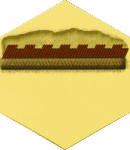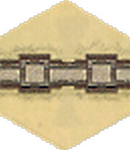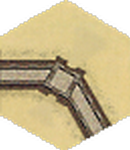Rampart


Movement: No movement restrictions.
Battle: A Rampart provides protection along the two or three forward facing hex sides.
CLOSE COMBAT: When attacked by an enemy unit across a hex side with a rampart, the defending unit disregards one sword symbol and may disregard one flag rolled against the unit. Note that the defending unit does not receive rampart protection when the enemy unit is not attacking across a hex side with the rampart (normally this is from a hex directly to the side or directly behind the two rampart protected hex sides).
RANGED COMBAT: A unit attacked through a forward facing rampart hex side may disregard one flag rolled against it.
Note: mounted units receive no protective benefit from rampart.
Line of Sight: A rampart hex side does not block line of sight.
Scalable City Walls



Movement:
Foot units (except War Machines) and Leaders: To move onto a scalable wall hex, a foot unit or leader must start its move from an adjacent hex to the scalable city wall hex. A foot unit or leader that enters a scalable wall hex must stop and may move no further on that turn. A foot unit or leader that moves off a scalable wall hex may only move onto an adjacent hex and may move no further on that turn. A Retreating or an Evading foot unit or leader does not have to stop when entering a scalable city wall hex.
Mounted Units and War Machines: A scalable city wall hex is impassable terrain for a Mounted unit or War Machine. These units may Close Combat an enemy unit on a scalable city wall hex, if they begin their turn adjacent to the scalable city wall hex with the enemy unit they are attacking. Neither unit may retreat or evade onto a scalable wall hex. A Mounted unit cannot momentum advance onto a scalable city wall hex.
Battle:
CLOSE COMBAT:
• When battling an enemy unit on a scalable city wall hex or a unit on a scalable city wall hex battling out, the unit rolls a maximum of 2 battle dice in Close Combat.
• A unit defending on a scalable city wall hex disregards one sword symbol and may disregard one flag rolled against it when attacked from any adjacent hex.
• A defending unit on a scalable city wall hex that cannot evade, or elects not to evade, will battle first (treat the defending unit as if it possesses a First Strike card, and treat the combat as a First Strike combat) when being attacked in Close Combat unless the attacking enemy unit is also on an adjacent scalable city wall hex.
RANGED COMBAT: A unit defending on a scalable city wall hex may disregard one flag rolled against it.
A Command card that adds additional dice in battle will modify the maximum number of battle dice that may be rolled.
Line of Sight: A scalable city wall hex blocks line of sight to units behind the scalable city wall hex and vise versa. Line of sight is not blocked between units on the same scalable city wall looking along the scalable city wall hexes.
Fortified City Walls



Use Scalable City Wall tiles.
Movement: Fortified City Walls are normally considered impassable terrain for all units, unless siege rules are in effect, as noted in the scenario special rules.
When siege rules are in effect, the attacking foot units have scaling ladders, and fortified city walls are treated as scalable walls.
Battle: No battle possible unless siege rules are in effect for the scenario.
Line of Sight: A fortified city wall hex blocks line of sight to units behind the fortified city wall hex and vice versa.
City Gate


Movement: Only friendly units, allied to the city, may move, retreat or evade onto or through a hex with a city gate. The gate is considered open and will not prevent these movements. Enemy units will follow the movement rules for a scalable city wall hex or a fortified city wall hex per city special rules.
Battle: A City Gate hex has the same battle rules and restrictions as a scalable city wall hex or a fortified city wall hex.
Line of Sight: A city gate hex blocks line of sight to units behind the city gate hex and vice versa.
Buildings

Movement:
Foot units (except War Machines) and Leaders: To move onto a building hex, a foot unit or leader must start its move from an adjacent hex to the building hex. A foot unit or leader that enters a building hex must stop and may move no further on that turn. A foot unit or leader that moves off a building hex may only move onto an adjacent hex and may move no further on that turn. A retreating or an evading foot unit or a leader may not enter a building hex.
Mounted Units and War Machines: A building hex is impassable terrain for a Mounted unit or War Machine. Both may Close Combat an enemy unit on a building hex. Neither unit may retreat or evade onto building hex. A Mounted unit cannot momentum advance onto a building hex.
Battle:
CLOSE COMBAT: When battling an enemy unit on a building hex or a unit on a building hex battling out, the unit rolls a maximum of 2 battle dice in Close Combat.
RANGED COMBAT: A unit may not target an enemy unit on a building hex and a unit on a building hex may not do ranged combat out of a building.
A Command card that adds additional dice in battle will modify the maximum number of battle dice that may be rolled.
Line of Sight: A building hex blocks line of sight.
Marsh

Movement: A unit must stop when it enters a marsh hex and move no further on that turn. The unit must also roll one battle die for a possible block loss. One block is lost when the unit’s symbol is rolled.
Retreating or evading units do not stop when entering a marsh hex. A unit that must retreat (or evades) onto or through a marsh hex must check for a possible block loss for each marsh hex it retreats or evades onto. Marsh block loss die rolls are made prior to removing blocks for unfulfilled map edge hex retreats.
Unattached leaders entering, retreating, evading or escaping into or through marsh hexes are also subject to block loss die rolls.
A unit that leaves a marsh hex may only move onto an adjacent hex regardless of its normal movement allowance.
A War Machine unit may not enter or retreat onto a marsh hex.
Battle: A unit may battle the turn it moves onto a marsh hex.
When battling an enemy unit on a marsh hex, a maximum of 2 battle dice are rolled in Close Combat. A unit that elects to advance onto a marsh hex after a successful Close Combat must check for possible block loss.
A unit on a marsh hex battling out will roll a maximum of 2 battle dice in Close Combat, and 1 die in Ranged Combat. A unit may still make a Momentum Advance out of the marsh hex onto the vacated hex after a successful Close Combat.
A Command card that adds additional dice in battle will modify the maximum number of battle dice that can be rolled.
Line of Sight: A Marsh hex does not block line of sight.
